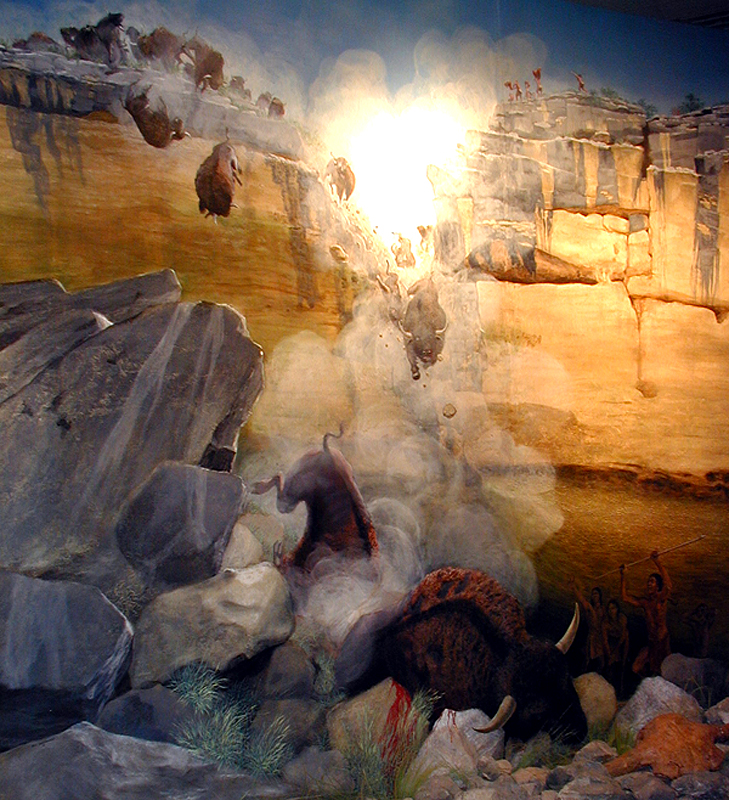
Bonfire mural by Nola Davis, Texas Parks
and Wildlife Department, original on display at Seminole Canyon
State Park.
Click images to enlarge
The Indians who lived in buffalo country knew well the behavioral characteristics of their favorite prey.
|
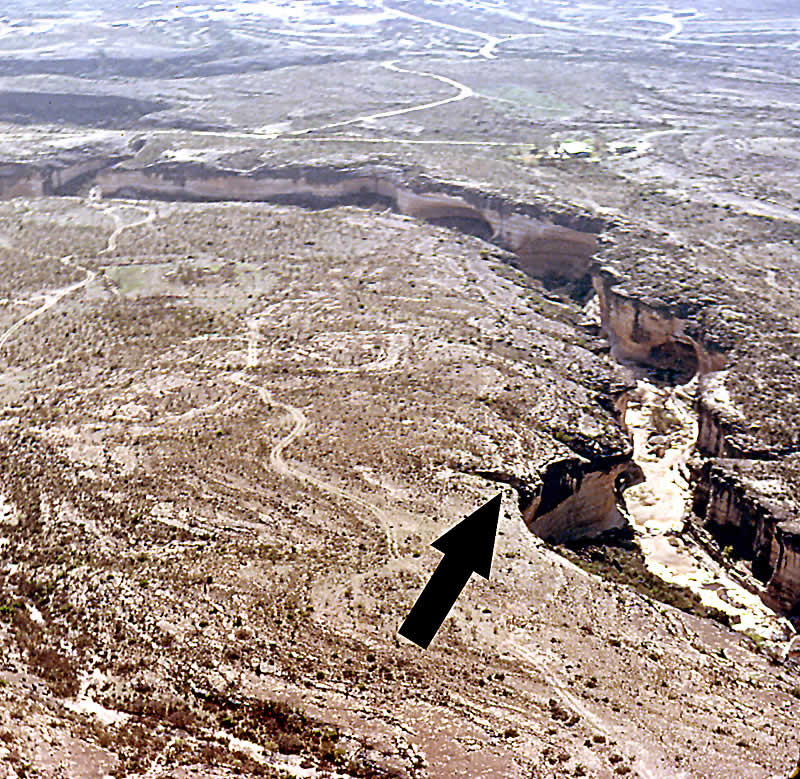
Aerial photograph of Mile Canyon. The black arrow points to
the spot where bison were driven over the cliff above Bonfire
Shelter. Photo by Dave Dibble. |
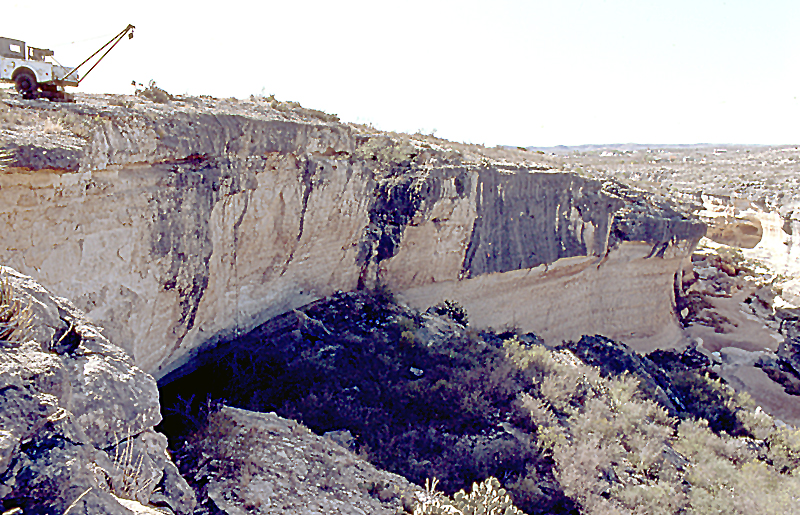
Bonfire Shelter as seen from the cliff
on the opposite side of the canyon. The huge rock blocks at
the base of the cliff once formed the roof of a truly immense
rockshelter, many times larger than the surviving part of
Bonfire Shelter. The roof collapse occurred prior to the first
known human use of the rockshelter sometime during the Late
Pleistocene. Photo by Jack Skiles. |
|
What archeologists and others call a bison "jump"
was, of course, not a jump at all. It was, at least from the buffalo's
perspective, a terrifying plunge of death. Exactly how Native American
hunters engineered the bison stampedes at Bonfire Shelter will never
be known. Based on historical accounts of similar bison kills in
the northern Great Plains, the Bonfire stampedes were probably carefully
orchestrated events that depended on luck and skill in equal measure.
Bison are creatures of the grasslands that behave like wild
cattle, their distant relatives. Gregarious by nature, bison stick
together for protection from wolves and other predators like humans,
forming herds that sometimes number in the thousands and stretch
for miles. Bison herds typically move slowly as the heavy animals
lumber along, grazing on grass as they go much like modern cattle.
But when threatened or frightened, a bison herd can stampede, forming
a thundering mass of panicking animals that moves as a single body.
Once a stampede has begun, the herd sometimes travels for miles
before exhaustion sets in or until the lead animals no longer perceive
danger and gradually bring the herd to a halt.
The Indians who lived in buffalo country
knew well the behavioral characteristics of their favorite prey.
Many different hunting strategies were devised including stalking,
surrounds, box canyon traps, and deep-snow quagmires. In the case
of bison jumps, such as those evidenced at Bonfire Shelter, conditions
had to be just right to take advantage of the bison's tendency to
stampede.
The terrain around Bonfire Shelter is very rugged
and deeply incised by canyons. Therefore, a bison jump could only
be staged when bison were in the immediate area, probably in the
flat uplands northeast of the site. Once a herd was spotted in the
area, the hunters would have had to carefully follow a plan that
depended on surprise and trickery. Bonfire Shelter must have been
recognized as having the right combination of flat or rolling terrain
ending in a steep and abrupt cliff. In fact, the cliff edge above
Bonfire is not visible due to the sloping terrain until just before
one reaches the edge. Even more important is the presence of a narrow,
steep-sided erosional gully or "cleft" that runs perpendicular
to the cliff face directly above Bonfire Shelter. This natural feature
would have blocked a possible escape route and essentially funneled
the bison off the cliff.
Having chosen this ideal spot, the hunters had to
wait until a herd wandered into a narrow target zone in the rolling
terrain upstream and uphill from the cliff above Bonfire Shelter.
There, one group of hunters had to trigger a stampede, perhaps by
using fire. For the scheme to work, the stampeding bison had to
be heading in the general direction of the shelter. But how did
they keep the herd from veering off the intended course? Historical
accounts suggest that additional hunters (including their family
members, women and children alike) would have erected brush or rock
barricades, used fires, or waved blankets to divert the bison away
from alternative routes and toward the cliff edge. The sudden appearance
of people springing up from nowhere presumably gave the bison additional
reason to panic.
If everything worked just right, the stampeding herd
would follow the desired path and gallop over the rise and suddenly
encounter the cliff. By then it was too late. The only possible
escape route—along the cliff—was cut off by the steep-sided
cleft. Bison can run as fast as 30-35 miles-per-hour. Even if the
galloping heavy animals could have stopped in time, the momentum
of the herd, most of whom followed the lead animals blindly, would
have (and obviously did) propel many bison over the edge.
The plunge of death must have been a horrific sight
to behold. In the space of a minute or less, dozens, or in some
cases hundreds, of bison plummeted down the cliff. They fell about
75 feet and landed on the cone-shaped pile of rocks that occurs
directly beneath the notch. Some of the animals rolled into the
cave, others must have fallen down the outside of the talus cone
down into the canyon floor. But most fell on top of one another.
An adult male modern bison can weigh as much as a ton (2,240 pounds)
and stands six feet high. The extinct bison species found at Bonfire
Shelter was much larger, an adult male may have weighed 3,500 pounds
and stood 7 1/2 feet high.
Typically, bison herds are led by the bigger bulls
(males) in their prime, with younger bulls, cows (females) and calves
following behind. This social structure may not have held up during
a stampede, when the normal order of things broke down. But if big
bulls were at the forefront of the Bonfire stampedes they would
have had an additional factor working against them when they suddenly
encountered the cliff edge and tried to stop. Male bison have most
of their weight centered over their front legs, an arrangement which
is useful when they lower their heads and charge other bulls during
battles to establish pecking order and mating rights, but not so
advantageous when trying to stop quickly from a dead run.
The fall alone must have killed many of the bison, but with so many,
some must have survived the fall, crippled perhaps, but attempting
to rise and bellowing in pain and terror. Hours may have passed
before the last bison were dispatched as the successful hunters
began the long process of butchering the bison, cutting up strips
of meat to be dried, and picking the best hides for skinning.
One last thought on the plunge of death. The Native
Americans who used the buffalo jump technique at Bonfire Shelter
sometimes met with success on a far greater scale than they intended
or needed. In Bone Bed 3 in particular, there is abundant evidence
that far more animals were killed than could be used. In fact, the
original analyst argued that Bone Bed 3 could represent a single
event in which as many as 800 animals died. Others think it more
likely that it represents several events, but even so these were
massive kills. Partially or entirely articulated (fitted together)
skeletons where found in the lower portions of Bone Bed 3. In other
cases archeologists recognized that only the most desirable parts
of the animals—especially the hindquarters—showed signs
of butchering. In other words, a great deal of the bison meat and
hides in the larger jump episodes went to waste.
The caricature of the noble savage, the idea that all pre-Columbian native peoples
lived in perfect harmony with nature, just doesn't jibe with the
evidence at Bonfire Shelter. Prehistoric bison hunters were sometimes wasteful and killed far more animals than they needed or used. But lest we get carried
away with this point, successful bison jumps were probably rare,
once-in-a-lifetime events. For at least 13,000 years after people
arrived on the continent, bison continued to thrive on the Great
Plains. The fact is that the immense bison herds of the Great Plains
were almost completely decimated by the late 1800s because of indiscriminate
hide hunters, most of whom were Anglos, who used rifles to kill
thousands and thousands of bison for nothing more than their hides.
Fortunately, the bison was saved from the brink of extinction and
is today thriving once again on large ranches on the Great Plains,
some owned and operated by Native Americans.
|
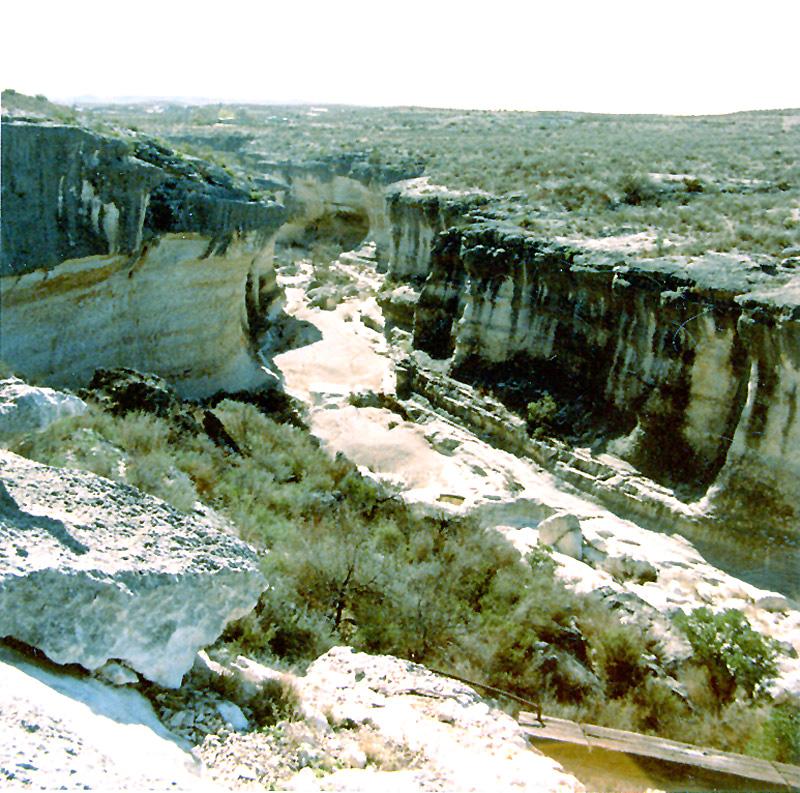
View of Mile Canyon looking downstream
from Bonfire Shelter. Photo by Steve Black. |
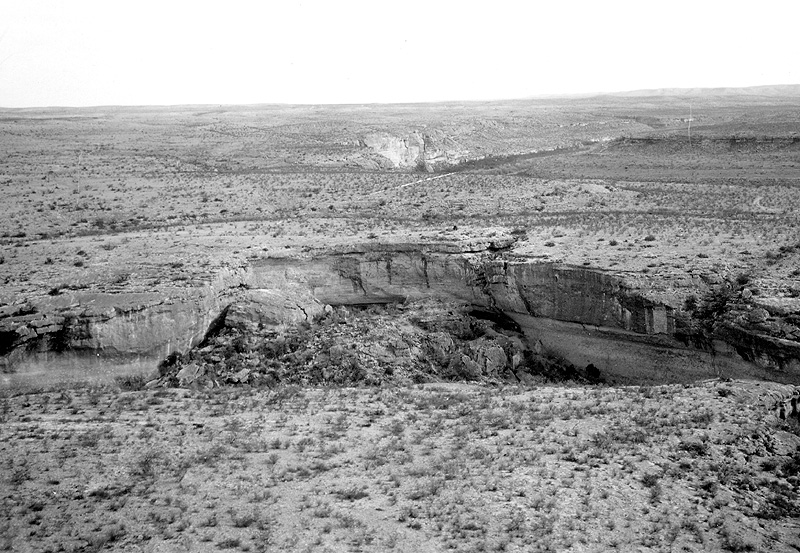
Aerial photograph of Bonfire Shelter and
immediate surroundings. Photo by Dave Dibble. |
|
In the space of a minute or less, dozens, or in some cases hundreds, of bison plummeted down the cliff. They fell about 75 feet and landed on the cone-shaped pile of rocks that occurs directly beneath the notch.
|

This almost complete skeleton of a yearling
bison calf was found in the lower part of Bone Bed 3. Apparently
it was buried beneath other fallen bison carcasses and was
never butchered. Photo by Dave Dibble. |
|